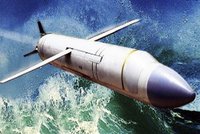Thirteen becomes lucky number for Putin and Bulava missile
 Thursday marked a successful test launch of Russia's ulava sea-based ICBM. This was the thirteenth launch, and only five launches of the new missiles carried out are considered to be relatively successful. Given the characteristics of the Russian political tradition, it is hardly an accident that the Bulava was launched on Prime Minister Vladimir Putin's birthday.
Thursday marked a successful test launch of Russia's ulava sea-based ICBM. This was the thirteenth launch, and only five launches of the new missiles carried out are considered to be relatively successful. Given the characteristics of the Russian political tradition, it is hardly an accident that the Bulava was launched on Prime Minister Vladimir Putin's birthday.

"The launch took place from the White Sea to the Kura test site in Kamchatka. The parameters of the missile trajectory were in the normal mode, combat units have successfully arrived at the Kura test site," stated the press service of the Defense Ministry.
Bulava-30 (NATO classification SS-NX-30) is a three-stage solid- propellant missile with an underwater sea-based launch. The first and second stages use solid fuel propellant, while the third stage uses liquid fuel to allow high maneuverability during warhead separation. The maximum range is 8 thousand km.
The first three missiles launched from a submarine (the first launch was carried out from an underwater bench) were successful. But then the problems started. The rockets deviated from the course and disbanded. The eighth and ninth launches that took place in 2008 were successful.
Then, sources reported about the issues with the engine, and the twelfth launch, which was to happen in late October of 2009, has been postponed several times. The nuclear submarine Dmitry Donskoy went to sea, but according to unofficial information, the missile did not come out of the mine because of the triggered automatic protection.
The twelfth launch was made on December 9, 2009 and ended in failure. According to official information from the Ministry of Defense of Russia, the rocket worked normally at first two stages, but at the third stage there was a technical problem.
According to the Ministry of Defense, the reason of the accident was the failure of actuating rod of the solid propellant manufactured by Permian NPO Iskra.
As stated in May of this year by Defense Minister Mr. Serdyukov, the problem of the failed launches of the Bulava missiles is in the assembly technology. This is not the issue of design errors and deficiencies of the manufacturers. It is not that simple to detect them. The product is the result of cooperative activities of hundreds of Russian defense enterprises. Although, according to the statements of some experts, the bulk of corrective works was carried out at Votkinsk Machine Building Plant.
"If possible failures are similar, then we will fix them, and if they are different, then the entire system will have to be broken down and we will have to figure out what's going on with the manufacturing and control. Then it will become clear that the monitoring of the production is wrong and should be completely changed," the head of the Defense Ministry stated in mid-September.
All this promised a serious scandal. It is worth mentioning that the main idea of the Bulava is the unification with the ground Topol-M. Therefore, the project was given for the development to the Moscow Institute of Thermal Technology, which created these land missiles. Miass Bureau named after Makeyev that had the experience of creating an underwater missile launch was removed from the project and engage in the development of another SLBMs, Sineva.
Moreover, two nuclear subs - the Alexander Nevsky and Vladimir Monomakh - and already adopted submarine Yury Dolgoruky were allocated specifically for the Bulava. That is, the overall costs associated with the Bulava weapons are enormous. By the way, as a result, the unification of the Bulava and Topol has not been achieved.
After successful testing, many involved in the project were certainly relieved. Despite the fact that the success of the thirteenth run requires confirmation in a few more successful launches, the Defense Ministry is rather optimistic.
The successful launch of the sea-based ballistic missile Bulava confirms the correctness of the design solutions proposed by the Moscow Institute of Thermal Technology (MIT) in the course of the project, as reported by Igor Korotchenko, a member of the public council under Ministry of Defense Minister, to RIA Novosti on Thursday.
"A distinctive feature of the Bulava is its ability to successfully overcome both current and future missile defense systems, a short active site of the flight path, resistance to the effects of weapons systems based on new physical fields, which in the next 10 years can be located in space," said Korotchenko.
The Ministry of Defense announced that the Bulava could be adopted by the Navy next year.
Sergey Nikolaev
Pravda.Ru
Subscribe to Pravda.Ru Telegram channel, Facebook, RSS!


